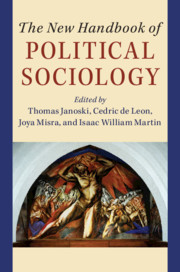Book contents
- The New Handbook of Political Sociology
- The New Handbook of Political Sociology
- Copyright page
- Dedication
- Contents
- Tables
- Figures
- Contributors
- Acknowledgments
- Introduction
- I Theories of Political Sociology
- II Media Explosion, Knowledge as Power, and Demographic Reversals
- III The State and Its Political Organizations
- IV Civil Society: The Roots and Processes of Political Action
- V Established and New State Policies and Innovations
- VI Globalization and New and Bigger Sources of Power and Resistance
- Index
- References
Introduction
New Directions in Political Sociology
Published online by Cambridge University Press: 22 February 2020
- The New Handbook of Political Sociology
- The New Handbook of Political Sociology
- Copyright page
- Dedication
- Contents
- Tables
- Figures
- Contributors
- Acknowledgments
- Introduction
- I Theories of Political Sociology
- II Media Explosion, Knowledge as Power, and Demographic Reversals
- III The State and Its Political Organizations
- IV Civil Society: The Roots and Processes of Political Action
- V Established and New State Policies and Innovations
- VI Globalization and New and Bigger Sources of Power and Resistance
- Index
- References
Summary
How will political sociology help us discern and analyze such changes now and in the next few decades? The future of politics is as uncertain as ever, but a brief overview of the history of political sociology may offer some clues to the theoretical challenges and opportunities ahead. For convenience, we divide the recent history of political sociology into three periods, suggesting that the field is now entering a fourth period with an expanding focus.
- Type
- Chapter
- Information
- The New Handbook of Political Sociology , pp. 1 - 32Publisher: Cambridge University PressPrint publication year: 2020
References
- 3
- Cited by

